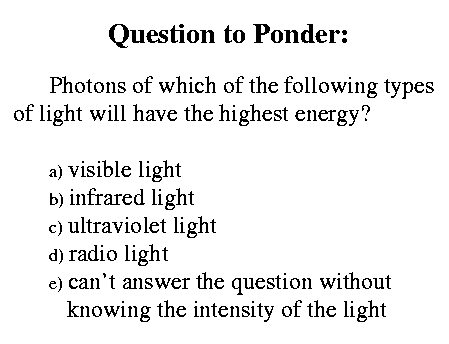|
|
You know my temperature's risin' and the jukebox blows a fuse. My heart's beatin' rhythm and my soul keep singing the blues. Roll over Beethoven and tell Tschaikowsky the news. Little Richard, Roll Over Beethoven |
Assignments:Problem Set #1 due Thursday 5pmRead Chapter 23, sections 23.3-23.4 (pp. 367-372) for Wednesday |

In Class:
So how do we find the energy to make a photon?
- recall that photons can be launched by wiggling charged particles.
(...change in E field...)
- recall also that matter is made up of charged stuff (e- p+)
- so wiggling matter will make light
How hard does it need to wiggle?
- well it has to have enough energy to make the photon
- the energy per particle in the matter must be high enough
- what is the energy per particle of a material ? ---> Temperature
Temperature
- it is a property more-or-less independent of material
- put two things in contact with one another
- e.g., the air in the room and this table
- they'll come to the same temperature
- energy will be traded between the two things until the
temps are the same
- Hot things cool off in the presence of cold stuff
- Cool things warm up in the presence of hot stuff
- microscopically, T has to do with the motions of the particles
for air, this makes some sense, but it's also true
for solid things, too.
-colder objects have less energy per particle, less motion
- T=0 is when there is no microscopic motion, no energy
per particle.
-- Absolute zero
- 273 C, -459 F, 0 K
- you can't get any colder
-- above absolute zero, there is motion, there is
energy per particle; T is not zero (in K)
-- average energy per particle of a material ~= 3/2 k T
where k, Boltzmann's const. = 1.38 x 10^-23 J/K
and T is in Kelvins
-- ex., room temperature -- 27 C 300 K
-- average energy per particle = 3/2 1.38x10^-23 x 300
= 6.2 x 10-21 J
the surface of the Sun
-- 6000 K; av. E = 3/2 1.38x10^-23 x 6000
= 1.2 x 10^-19 J
--> HOT OBJECTS HAVE MORE ENERGY PER PARTICLE
We can use this energy to make photons
this motion energy can be a source of photon emission
- wiggling charged particles
- energy is available
- amount of available energy depends on T
-- what kind of photons?
depends on how much energy you've got
more accurately on how much energy per particle
you've got
Set photon energy equal to average energy per particle
E = h nu = h c /lambda = 3/2 k T
- E = 3/2 k T
k = Boltzmann's constant 1.38e-23 J/K
If we used this energy to make a photon, what kind of photon would it be?
- E = 3/2 k T = h c / lambda
= 3/2 1.38e-23 T = 6.626e-34 3e8 / lambda
= 2e-23 T = 2e-25 / Lambda
= lambda = 0.01/T
The typical wavelength that could be made from the energy
per particle available in material at temp T is this.
The details are much more complicated, but give pretty much the same result.
>>>>>All things with T>0 emit light.<<<<<
Planck fn for thermal emission, sometimes called the blackbody function
(i.e., color comes from temperature, not paint)
PLOT: x-axis= wavelength, yaxis= energy emitted;
emission at a variety of wavelengths
- all sorts of different energy photons can be produced
however, the most energy is emitted at a characteristic
wavelength
- the "peak" of the function
- the peak is related to the temp in the way we saw
above for the typical photon
lambda = 0.003/T
factor of three arises in the details
IMPORTANT CAVEAT: this is a formula to measure the PEAK of the thermal
emission spectrum. This isn't the only light that's emitted
warm bodies emit light at a variety of wavelengths
--> called broad spectrum emission
-- see red and blue bars at bottom
however, because the peak of most bb spectra is so pronounced
the color we see (or measure) is close to the wavelength of
the peak
Raise temperature and what happens?
1) emission at all wavelengths increases
2) biggest increase at short wavelengths
3) peak of spectrum moves toward shorter wavelengths
|
![]()